Persian jeweled rice | Shirin Polo is a beautiful, fancy rice dish, often served at weddings and other festive celebrations. Shirin in Farsi means sweet and how sweet is this rice? Colorful bursts of fresh and dried fruits, crunchy nuts, sweet citrus, and pops of fruit color draping over a steaming bed of fluffy royal rice…that’s our Shirin polo!
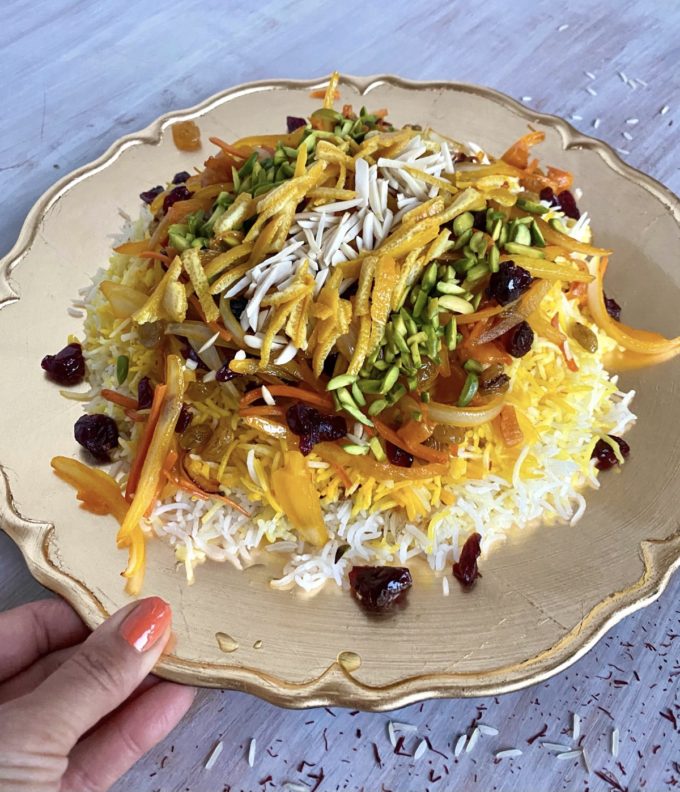
This royal wedding rice has many titles. It is sometimes called Javaher polo. Javaher means jewel in Farsi and this rice is certainly a gem both in color and in flavor. Morasa is another word for jewels in Farsi. Lastly, I’ve heard folks refer to this polo as a bride’s rice dish. Whatever you choose to call it, it is surely a culinary treasure.
A rice dish of many names –
- Persian Jeweled Rice
- Persian Wedding Rice (a.k.a. Brides Rice)
- Shirin Polo (Farsi for sweet rice)
- Javaher Polo (Farsi for jeweled rice)
- Morasa Polo (Farsi for rice with jewels)
The colorful, aromatic, sweet topping is what makes this beautiful rice dish stand out from the rest.
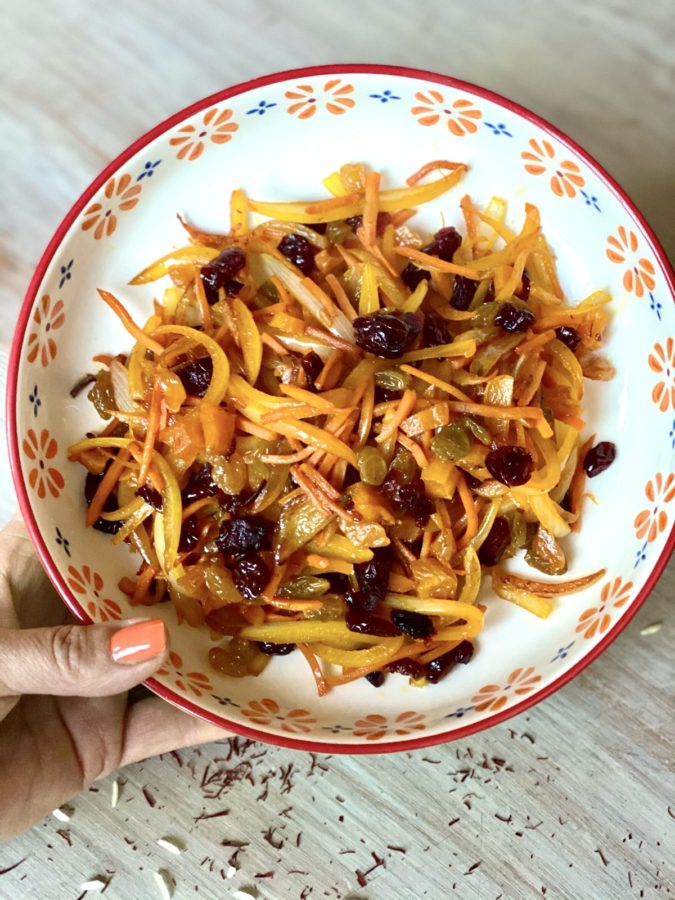
Traditional
Traditionally, Shirin Polo is fantastically rich, containing onions and fruits that have been sauteed in butter and oil. It is vibrantly colored like bright and royal gems. I think of it as an assault of all the senses in the best way. Citrus zest is candied in sugar. Nuts are toasted in butter and oil. Essences of rosewater, saffron, and sometimes even a bit of orange blossom water, steam through and through the fluffy long-grain polo. The result is a candied, buttery, incredibly aromatic, and heavenly topping that I love enough to eat straight up and plain.
Modern
As I mentioned, in Iranian culture, it’s a custom to serve this royal and elegant rice is at weddings and on the most special occasions. In our modern lifestyles, we love to introduce Shirin polo, Persian sweet rice, to western holidays and traditions like Thanksgiving and Christmas. Although tart barberries (called ‘zereshk’ in Farsi) are traditionally used in this rice, we substitute zereshk with dried cranberries for western holidays. The cranberries are a great way to tie in our old cultural traditions with modern American traditions.
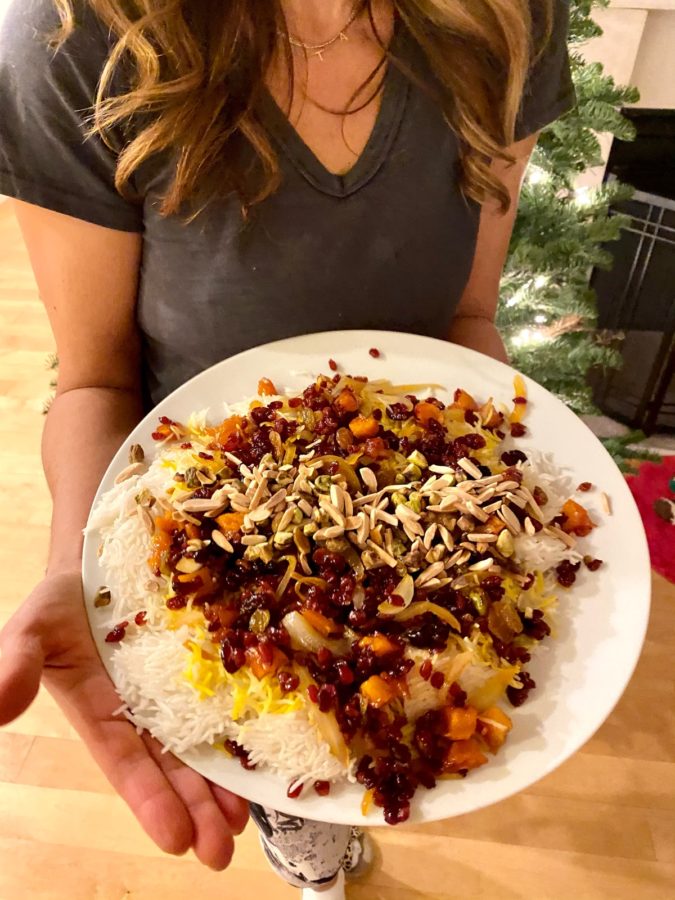
Dried fruit ingredient options
- raisins (in Farsi keshmesh) & dates
- dried apricots/dried peaches
- tart barberries (zereshk in Farsi)
- dried cranberries/dried cherries
Dried fruit and berries bring sweet flavor and bright color to a gorgeous rice platter. When cooked just right they glisten and glow. My favorite combination of colors and flavors is yellow raisins, orange-colored dried apricots or dried peaches, and reddish-colored dried cranberries or dried cherries. Yum!
Sprinkle on some crunchy, toasted nuts and now we’re really in business. Persian trail mix, called ‘ajeel’ in Farsi, is made with similar dried fruit and nuts. Traditionally shirin polo is made with slivered almonds and pistachios.
Nut toppings
- pistachios
- almonds
- walnuts
In our modern versions and meshing with American festivities, sometimes we’ll add pecans which pair nicely with cranberries and the holidays. If time allows, lightly toasting slivered nuts makes this dish even more delicious.
But the fun doesn’t stop there. Creativity is key with this jewel of a rice recipe. In most Javaher (jeweled) Polo (rice) recipes candied carrots and orange rind is added for the bright orange color addition. Fresh pomegranate arils are a modern twist.
More fresh topping possibilities
- carrots
- orange rind
- pomegranate
In traditional shirin polo recipes, a generous hand is used in adding sugar. Typically 1/2 cup or so of sugar is added to the orange peel and julienned carrots in the sauteing step. To keep things on the lighter and healthier side, I reduce the amount of sugar in our recipe without sacrificing sweet flavor.
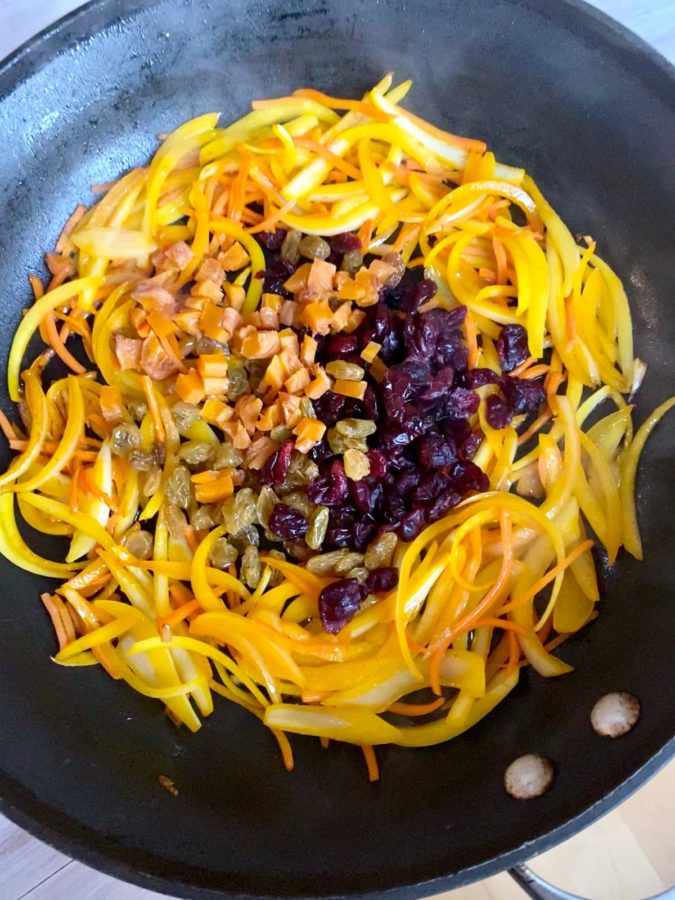
Cooking Tips –
If time is on your side and you’d like to make it in the most traditional manner, make parboiled rice, they layer in the ‘topping’ as I call it into the pot in the same method as we do in making other layered Persian rice dishes such as Lentil and Date Rice | Adas Polo and Persian Fava Dill Rice | Baghali Polo.
As much as I appreciate the method of layering rice dish in the cooking step to spread the flavors all throughout the rice pot, for this particular recipe, I normally make the rice separately and the topping separately, then drape the beautiful jeweled topping on top of a heap of the white Basmati rice just before serving. The topping is simply too colorful and beautiful to hide buried underneath layers of rice. Also, by spooning the sweet toppings over the rice, it’s easy to scoop up and enjoy as much or as little of the sweet, nutty topping as desired.
As per usual, in my modern take of old Persian recipes, I cut down on the butter, sugar, and oils while maintaining the spices and rich flavors. I like using olive oil for many things in the kitchen, however, with Persian rice, we find it changes the flavor. I use vegetable cooking oil. Although the orange peel and carrots are traditionally candied with sugar while cooking, I believe the dried fruit we use in our recipe to be sweet enough without further adding sugar to this recipe.

Lighten it up
- substitute the butter with vegetable oil
- cut down on the portions of added sugar (we reason that dried fruit along with carrots is sweet enough)
In today’s modern lifestyles we typically don’t have all day to spend in the kitchen. We’re working, raising families, staying physically fit, and hopefully otherwise expanding our minds, interests, and our skillsets. At the same time, we want to be able to enjoy the interesting flavors and foods of our royal ancestors.
Shortcuts
- use pre-packaged sliced, dried orange peel
- pre-packed, julienned, shopped matchstick carrots
- deseeding pomegranate using the water method
Making jeweled rice is not hard. There are so many lovely tastes and topping ingredients. You can substitute or skip any to accommodate any special needs (i.e. nut allergies) and to your liking.
Tips for dealing with orange peels
- remove the inner white pith of orange peel and
- soak orange zest in water or cook in boiling water – both help to cut down the bitter taste of the orange peel
Middle eastern and Persian markets often carry sliced orange peels in dry form. The steps for dealing with dried peels are the same however it helps to soak the dried slices in water overnight.
If you choose to add fresh pomegranate and sprinkle extra jewels on the aromatic rice, watch this video for how to deseed a whole pomegranate using the easy water method:
To honor this special dish, take your time arranging the rice as the presentation of this queen of a rice dish is everything. Some people choose to lay each specialty topping ingredient in strips or stripes across the top of the rice. I like the taste of the mix and since I’d be scrambling it up on my plate anyhow, I combine my topping ingredients before ‘dressing’ the rice…unless we are having guests and in that case, I just might go for a pretty pattern.
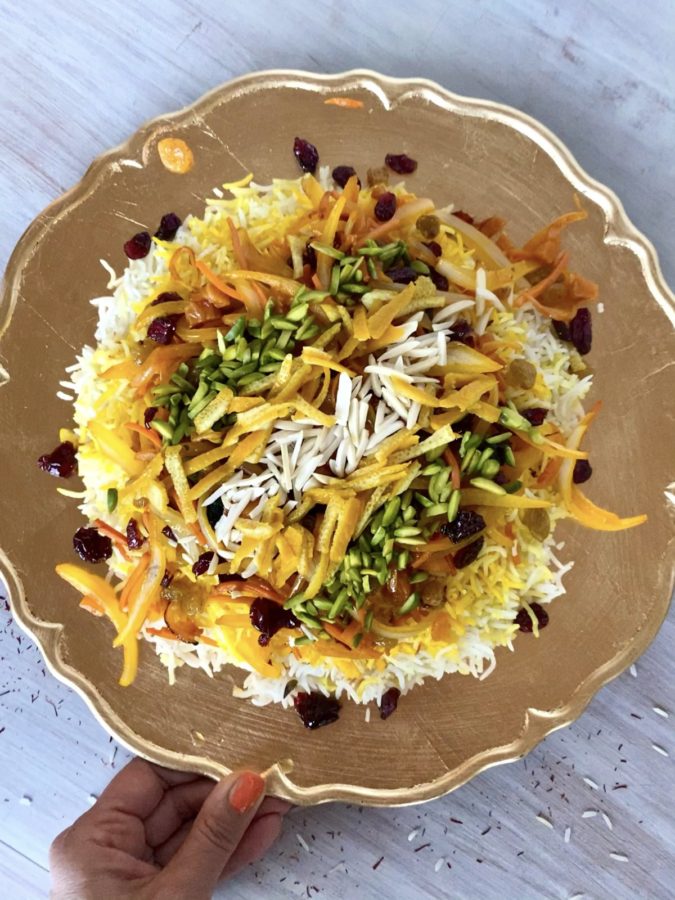
Most often, Javaher polo is served with saffron or turmeric roasted chicken. This rice dish is quite lovely paired with any type of chicken or with roast turkey. I find our jeweled rice to be rich, beautiful, and hearty enough to stand alone as the main attraction of any meal. Serving this morasa polo solo lends it to a tasty vegetarian meal.
Shirin polo, also known as Javaher polo, Morasa polo, and Persian jeweled rice is easily my favorite of all the varieties of Persian rice.
To learn more about Persian rice and a little behind the scene story (hint, it wasn’t on the menu but we still ate it at our wedding!) listen to Modern Persian Food, “Episode 3: Rice” where my co-host, Beata, and I talk about all our favorite versions.
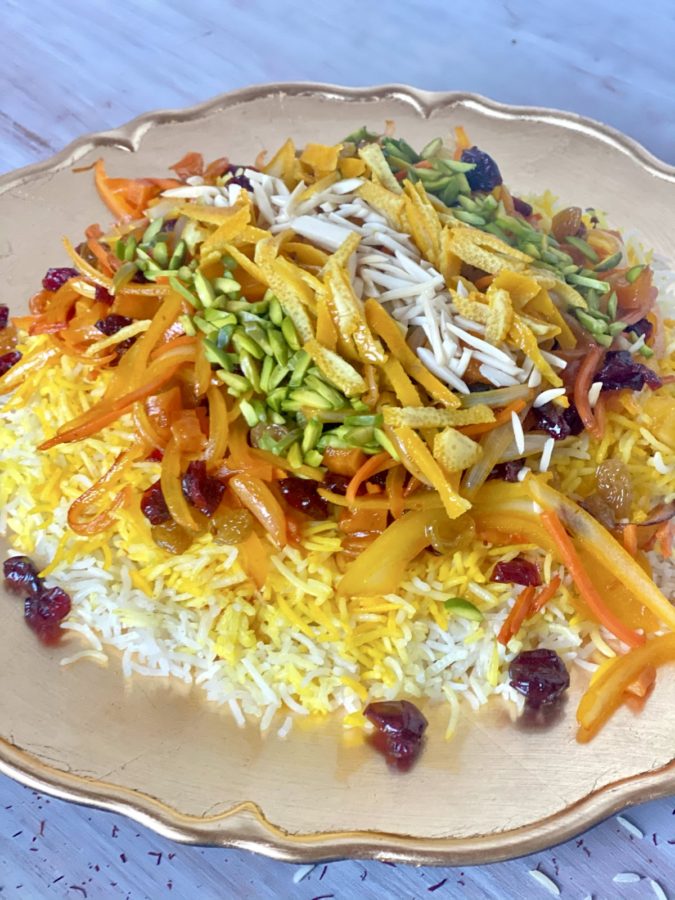
I have one last tidbit to share. Remember all those beautiful dried fruits and nuts you collected for this recipe? I have a rollover recipe share that uses many of the same ingredients. My podcast partner, Beata, turned me on to her Jeweled Cinnamon Rolls and I have since made them 3 times. In my version, I use gluten-free pastry dough sheets and the result is nothing short of cozy, sophisticated, and delicious.
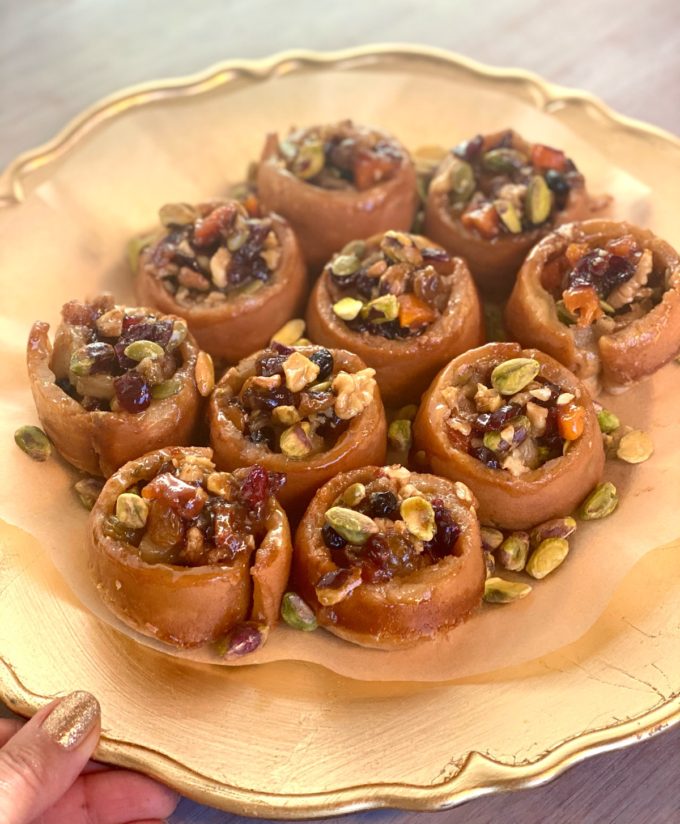
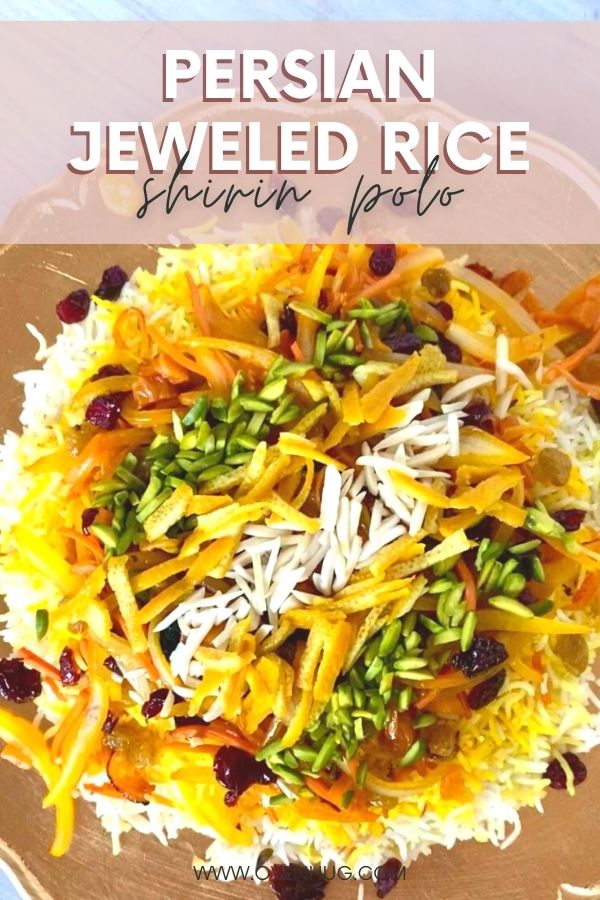
Persian Jeweled Rice | Shirin Polo
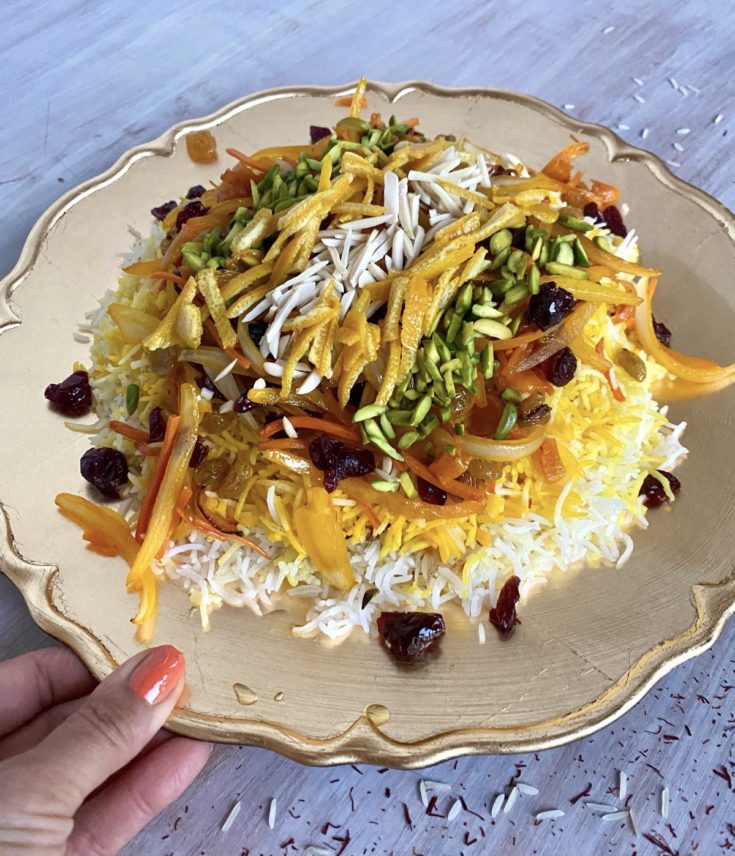
Persian jeweled rice | Shirin Polo is a beautiful, fancy rice dish, often served at weddings and other festive celebrations. Shirin in Farsi means sweet and how sweet is this rice? Colorful bursts of fresh and dried fruits, crunchy nuts, sweet citrus, and pops of pomegranate draping over a steaming bed of fluffy royal rice. That's our Shirin polo!
Ingredients
Rice
- 3 cups parboiled, steamed white Basmati long grain rice (see the post How to Parboil Rice)
- 2 tablespoons cooking oil
- 1/4 teaspoon saffron, bloomed and dissolved in 2 tablespoons of rose water
Topping
- 2 tablespoons olive oil
- 1 medium-sized yellow onion, sliced
- 2 tablespoons of sugar
- 1/4 cup shredded or julienned carrots
- 1 cup orange or tangerine peel
- 1/2 cup water
- 1 tablespoon orange blossom water
- 1 cup finely chopped dried fruit (I use yellow raisins, dried apricots or dried peaches, and dried cranberries or dried cherries)
- 1/4 teaspoon saffron, bloomed and dissolved in 2 tablespoons of rose water
- 1/4 cup slivered almonds
- 1/4 cup slivered pistachio nuts
- 1/4 pomegranate arils (optional)
Instructions
- Pour oil in the bottom of a large pot, add the tahdig of choice, then cook rice on low heat for about 45 minutes.
- Peel orange and remove the inner pith (the bitter white part just beneath the zest). Cut into thin strips
- Boil the orange zest strips in water for about 2 to 3 minutes
- Drain the water from the orange peel zest and fill the pot with about 1/2 cup of water a tablespoon of sugar and bring to a boil again
- Remove pot the orange zest from the heat
- Add orange blossom water to the pot of sugar water with the zests and set aside
- Heat the olive oil and saute the sliced onions for about 2 to 3 minutes
- Add the carrots and continue sauteing and cooking for another 1 to 2 minutes
- Add all of the dried fruit and saute for another 3 to 5 minutes
- Lastly, add the slivered nuts if choosing to toast the nuts (nuts may be added uncooked as an option)
- Remove the soaking orange zests from the sweetened orange blossom water
- To serve, mound the steaming, cooked rice on a large platter. Gently spoon on the onion, carrot, raisin, and nut topping over the rice. Sprinkle the candied orange peel on the very top. Add pomegranate arils for an extra pop of color.
Notes
The most time-consuming part of making this rice is around the steps for removing the bitterness from the orange zest.
If time allows, soak the peels (after the pith has been removed) in water overnight. Do a few rounds of boiling the zest in water and draining. Each time helps remove more of the bitterness.
In the final round of boiling the orange zest add some sugar. Then allow the pot of sweetened water and orange zest to cool. Lastly, add orange blossom water for even more orange essence and aromas.
Nutrition Information:
Yield:
6Serving Size:
1Amount Per Serving: Calories: 416Total Fat: 14gSaturated Fat: 2gTrans Fat: 0gUnsaturated Fat: 12gCholesterol: 0mgSodium: 52mgCarbohydrates: 67gFiber: 6gSugar: 28gProtein: 7g
Oven Hug is a participant in the Amazon Services LLC Associates Program, an affiliate advertising program designed to provide a means for us to earn fees by linking to Amazon.com and affiliated sites.

Leave a Reply